|
CHAPTER IV.
The Common Frog | ||
4. CHAPTER IV.
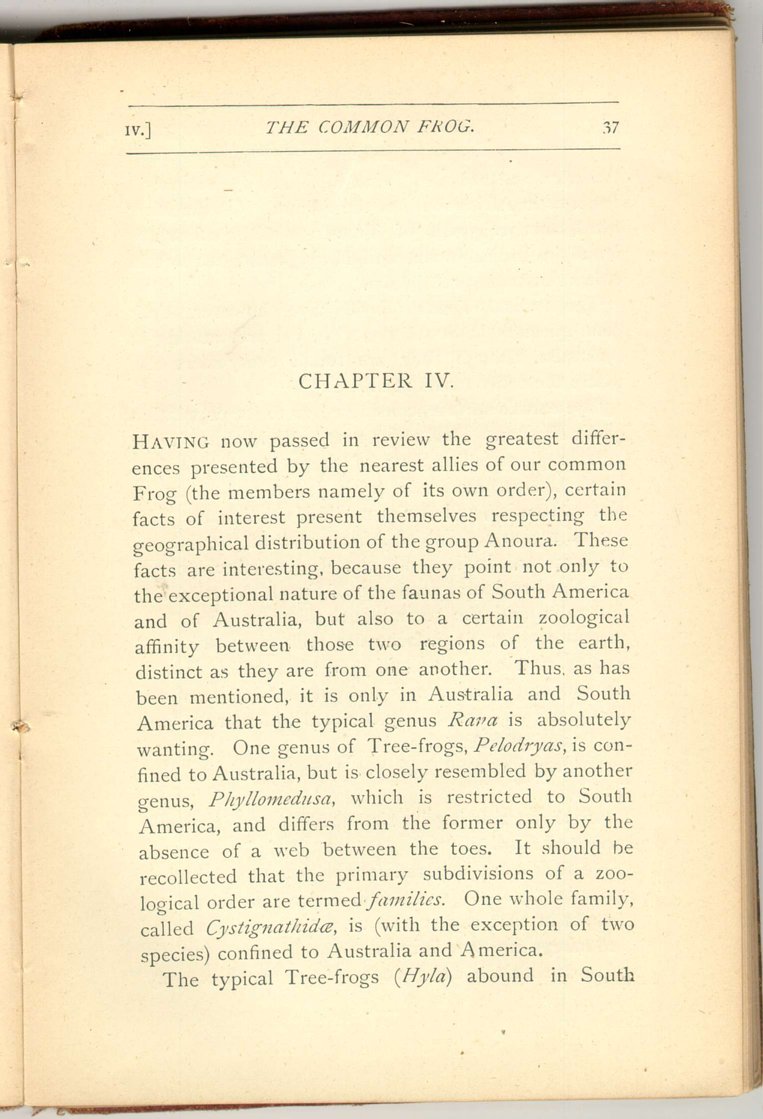 [Description:
Image of page 37.
]
[Description:
Image of page 37.
]
Having now passed in review
the greatest differences presented by the nearest
allies of our common Frog (the members namely of
its own order), certain facts of interest present
themselves respecting the geographical distribution
of the group Anoura.
These facts are interesting, because they point not
only to the exceptional nature of the faunas of South
America and of Australia, but also to a certain
zoological affinity between those two regions of the
earth, distinct as they are from one another. Thus,
as has been mentioned, it is only in Australia and South
America that the typical genus
Rana is absolutely wanting. One
genus of Tree-frogs, Pelodryas
, is confined to Australia, but is closely
resembled by another genus,
Phyllomedusa, which is restricted to
South America, and differs from the former only by
the absence of a web between the toes. It should
be recollected that the primary subdivisions of a
zoological order are termed families.
One whole family, called
Cystignathidœ, is (with the
exception of two species) confined to Australia and
America.
The typical Tree-frogs ( Hyla) abound in South
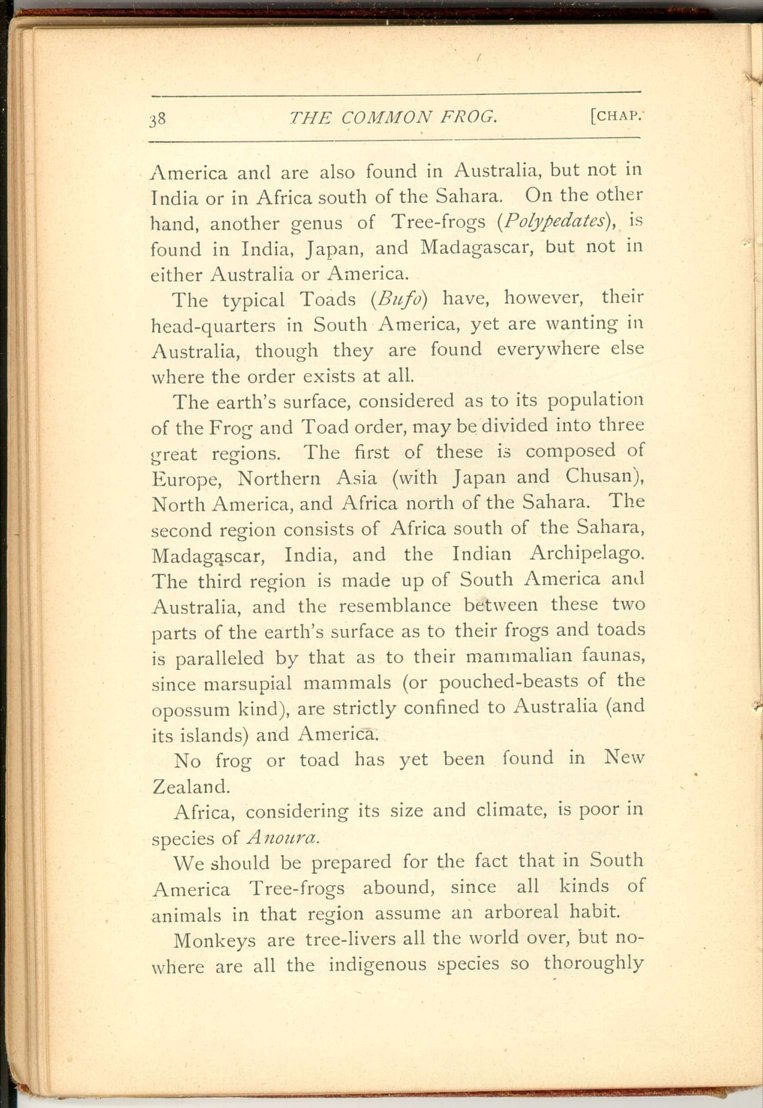 [Description:
Image of page 38.
]
[Description:
Image of page 38.
]
The typical Toads (Bufo) have, however, their head-quarters in South America, yet are wanting in Australia, though they are found everywhere else where the order exists at all.
The earth's surface, considered as to its population of the Frog and Toad order, may be divided into three great regions. The first of these is composed of Europe, Northern Asia (with Japan and Chusan), North America, and Africa north of the Sahara. The second region consists of Africa south of the Sahara, Madagascar, India, and the Indian Archipelago. The third region is made up of South America and Australia, and the resemblance between these two parts of the earth's surface as to their frogs and toads is paralleled by that as to their mammalian faunas, since marsupial mammals (or pouched-beasts of the opossum kind), are strictly confined to Australia (and its islands) and America.
No frog or toad has yet been found in New Zealand.
Africa, considering its size and climate, is poor in species of Anoura.
We should be prepared for the fact that in South America Tree-frogs abound, since all kinds of animals in that region assume an arboreal habit.
Monkeys are tree-livers all the world over, but nowhere are all the indigenous species so thoroughly
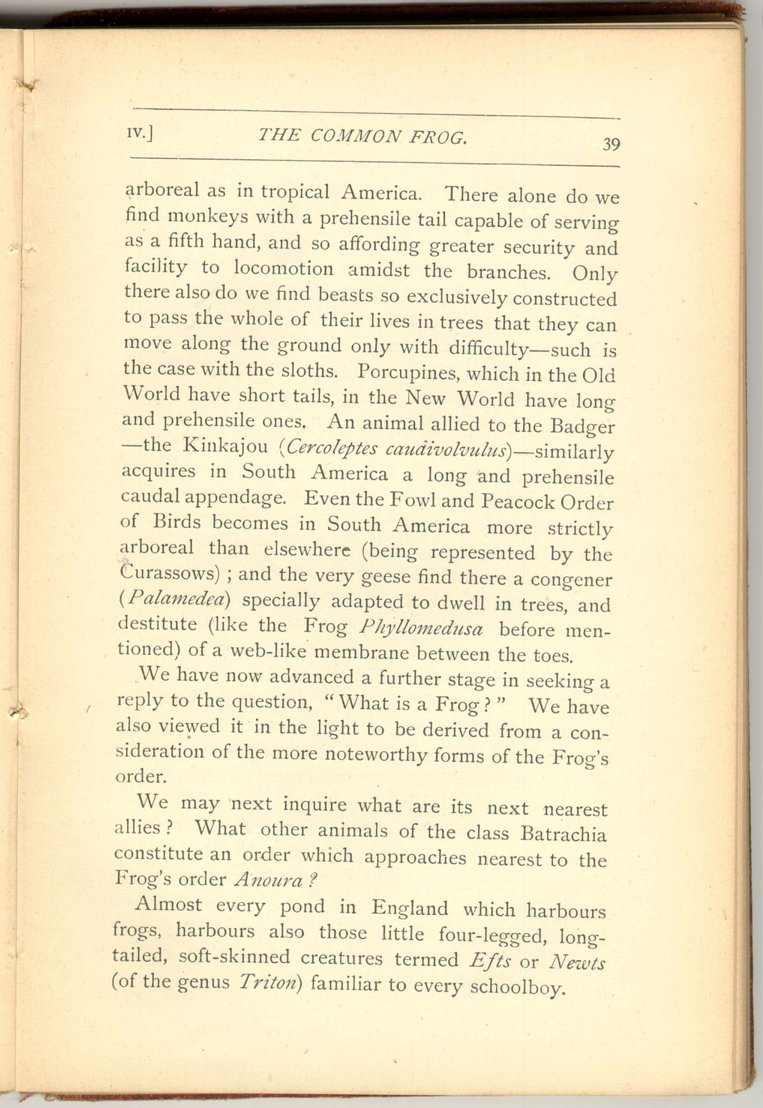 [Description:
Image of page 39.
]
[Description:
Image of page 39.
]
We have now advanced a further stage in seeking a reply to the question, "What is a Frog?" We have also viewed it in the light to be derived from a consideration of the more noteworthy forms of the Frog's order.
We may next inquire what are its next nearest allies? What other animals of the class Batrachia constitute an order which approaches nearest to the Frog's order Anoura?
Almost every pond in England which harbours frogs, harbours also those little four-legged, long-tailed, soft-skinned creatures termed Efts or Newts (of the genus Triton) familiar to every schoolboy.
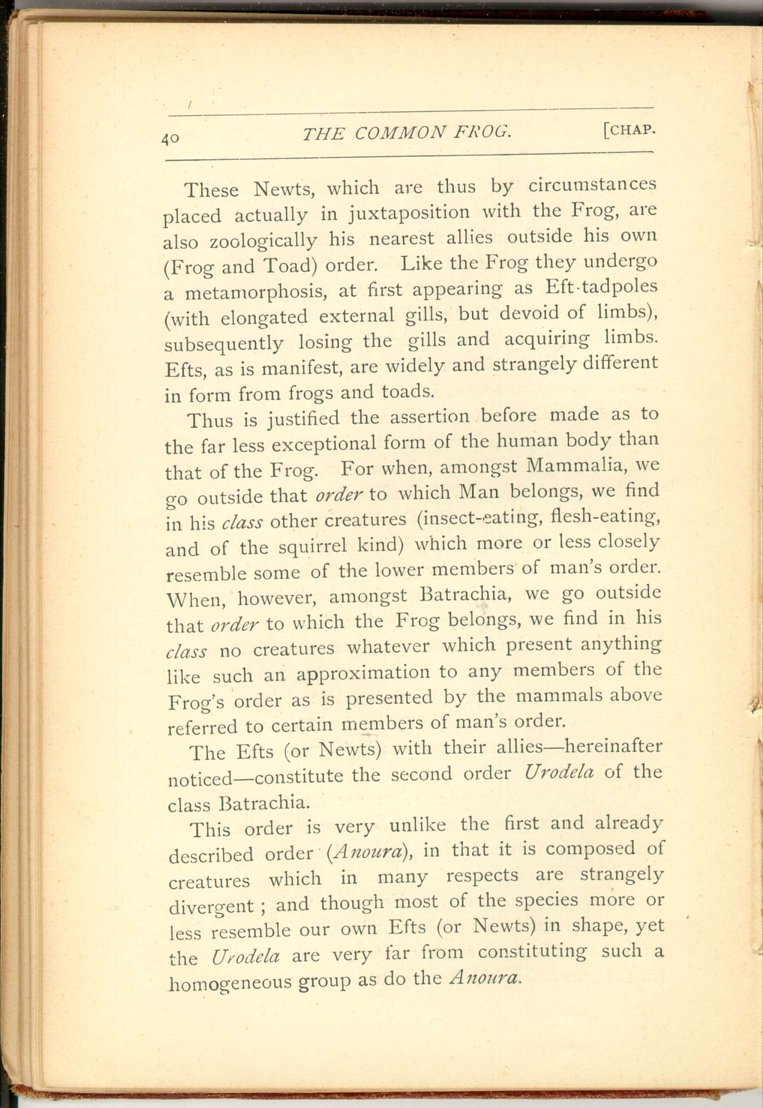 [Description:
Image of page 40.
]
[Description:
Image of page 40.
]
These Newts, which are thus by circumstances placed actually in juxtaposition with the Frog, are also zoologically his nearest allies outside his own (Frog and Toad) order. Like the Frog they undergo a metamorphosis, at first appearing as Eft-tadpoles (with elongated external gills, but devoid of limbs), subsequently losing the gills and acquiring limbs. Efts, as is manifest, are widely and strangely different in form from frogs and toads.
Thus is justified the assertion before made as to the far less exceptional form of the human body than that of the Frog. For when, amongst Mammalia, we go outside that order to which Man belongs, we find in his class other creatures (insect-eating, flesh-eating, and of the squirrel kind) which more or less closely resemble some of the lower members of man's order. When, however, amongst Batrachia, we go outside that order to which the Frog belongs, we find in his class no creatures whatever which present anything, like such an approximation to any members of the Frog's order as is presented by the mammals above referred to certain members of man's order.
The Efts (or Newts) with their allies-hereinafter noticed—constitute the second order Urodela of the class Batrachia.
This order is very unlike the first and already described order (Anoura), in that it is composed of creatures which in many respects are strangely divergent; and though most of the species more or less resemble our own Efts (or Newts) in shape, yet the Urodela are very far from constituting such a homogeneous group as do the Anoura.
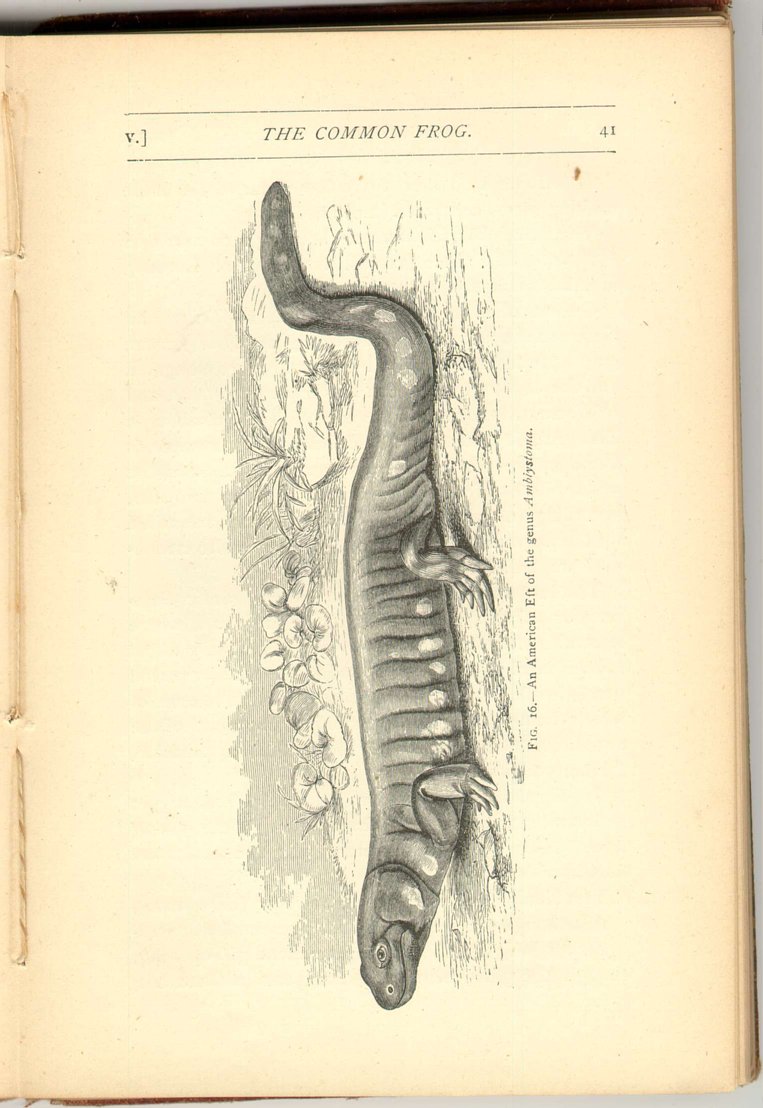 [Description:
Image of page 41.
]
[Description:
Image of page 41.
]
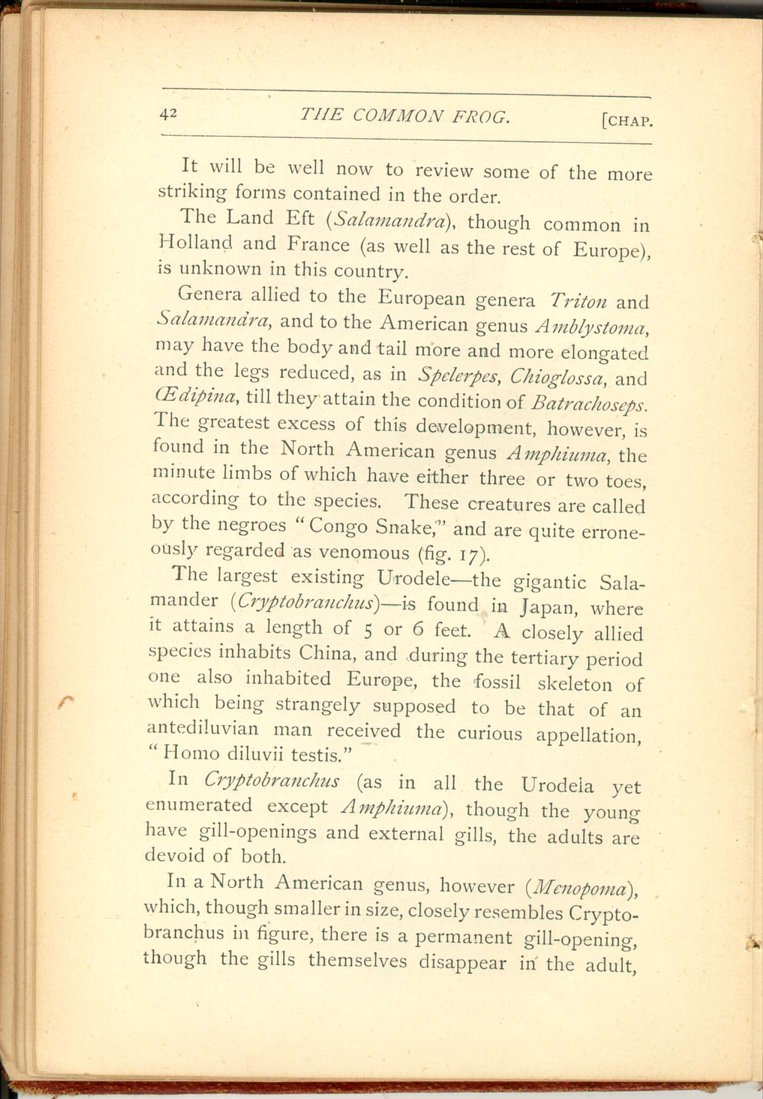 [Description:
Image of page 42.
]
[Description:
Image of page 42.
]
It will be well now to review some of the more striking forms contained in the order.
The Land Eft (Salamandra), though common in Holland and France (as well as the rest of Europe), is unknown in this country.
Genera allied to the European genera Triton and Salamandra, and to the American genus Amblystoma, may have the body and tail more and more elongated and the legs reduced, as in Spelerpes, Chioglossa , and Œdipina , till they attain the condition of Batrachoseps. The greatest excess of this development, however, is found in the North American genus Amphiuma, the minute limbs of which have either three or two toes, according to the species. These creatures are called by the negroes "Congo Snake," and are quite erroneously regarded as venomous (fig. 17).
The largest existing Urodele—the gigantic Salamander (Cryptobranchus)—is found in Japan, where it attains a length of 5 or 6 feet. A closely allied species inhabits China, and during the tertiary period one also inhabited Europe, the fossil skeleton of which being strangely supposed to be that of an antediluvian man received the curious appellation, " Homo diluvii testis."
In Cryptobranchus (as in all the Urodela yet enumerated except Amphiuma), though the young have gill-openings and external gills, the adults are devoid of both.
In a North American genus, however (Menopoma), which, though smaller in size, closely resembles Cryptobranchus in figure, there is a permanent gill-opening, though the gills themselves disappear in the adult,
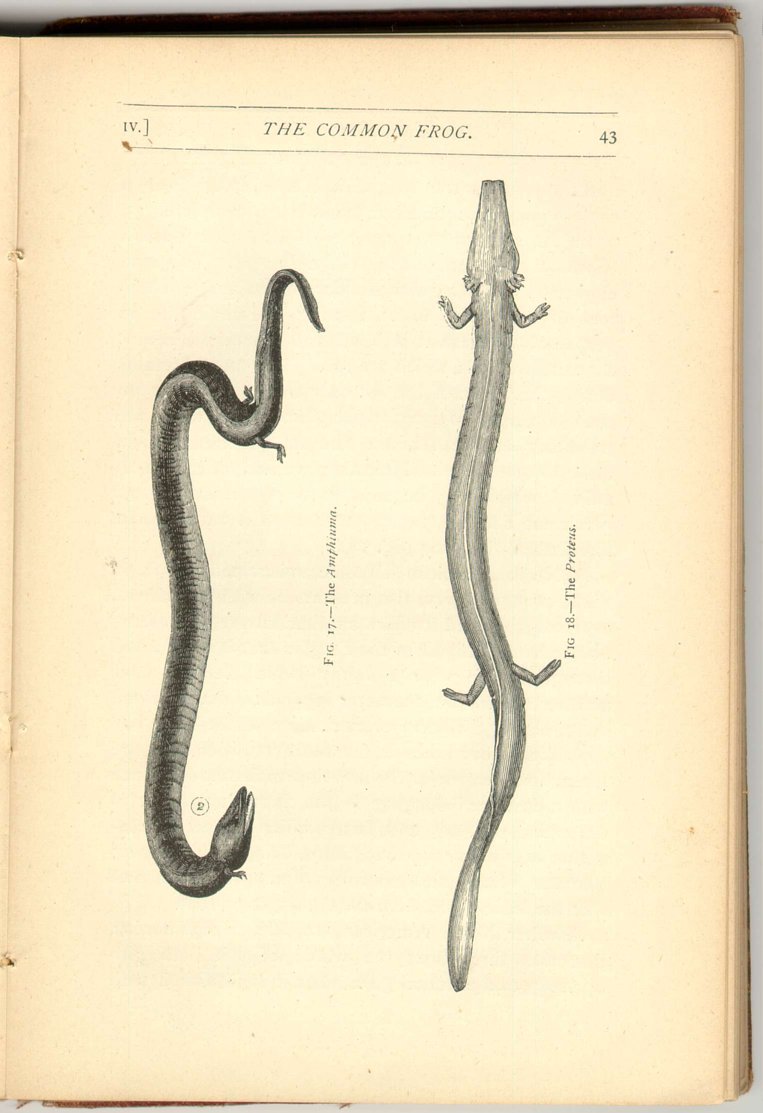 [Description:
Image of page 43.
]
[Description:
Image of page 43.
]
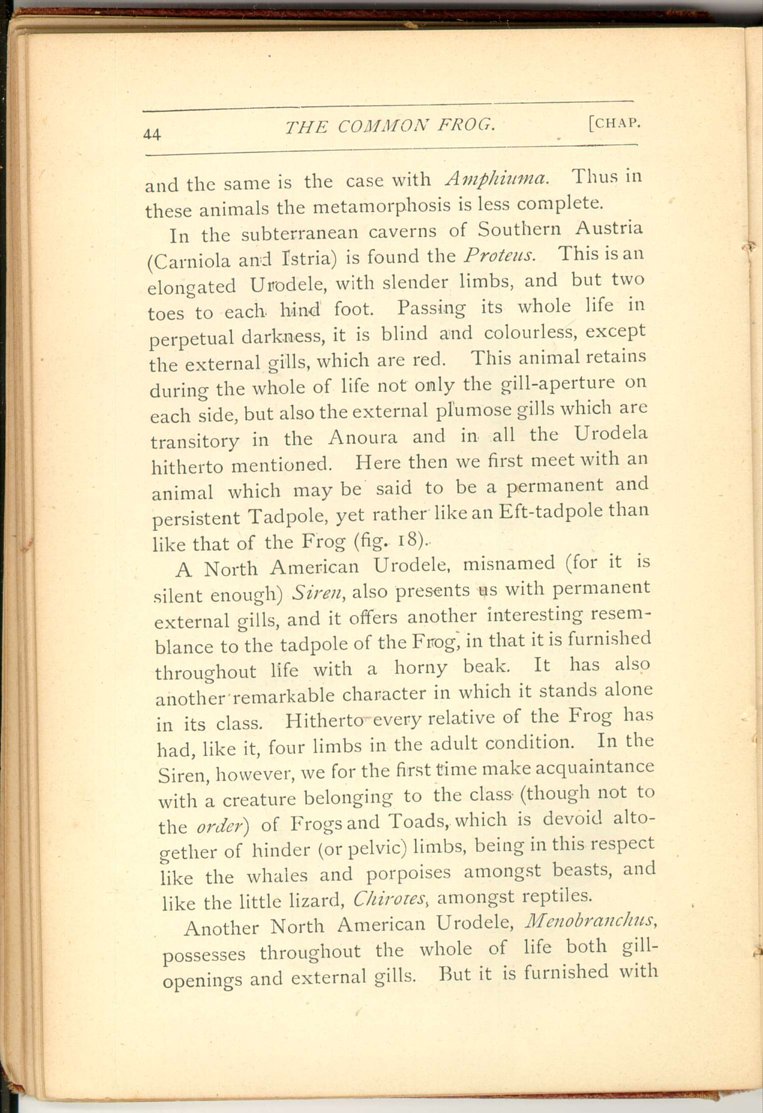 [Description:
Image of page 44.
]
[Description:
Image of page 44.
]
In the subterranean caverns of Southern Austria (Carniola and Istria) is found the Proteus. This is an elongated Urodele, with slender limbs, and but two toes to each hind foot. Passing its whole life in perpetual darkness, it is blind and colourless, except the external gills, which are red. This animal retains during the whole of life not only the gill-aperture on each side, but also the external plumose gills which are transitory in the Anoura and in all the Urodela hitherto mentioned. Here then we first meet with an animal which may be said to be a permanent and persistent Tadpole, yet rather like an Eft-tadpole than like that of the Frog (fig. 18).
A North American Urodele, misnamed (for it is silent enough) Siren, also presents us with permanent external gills, and it offers another interesting resemblance to the tadpole of the Frog, in that it is furnished throughout life with a horny beak. It has also another remarkable character in which it stands alone in its class. Hitherto ever relative of the Frog has had, like it, four limbs in the adult condition. In the Siren, however, we for the first time make acquaintance with a creature belonging to the class (though not to the order) of Frogs and Toads, which is devoid altogether of hinder (or pelvic) limbs, being in this respect like the whales and porpoises amongst beasts, and like the little lizard, Chirotes, amongst reptiles.
Another North American Urodele, Menobranchus, possesses throughout the whole of life both gill-openings and external gills. But it is furnished with
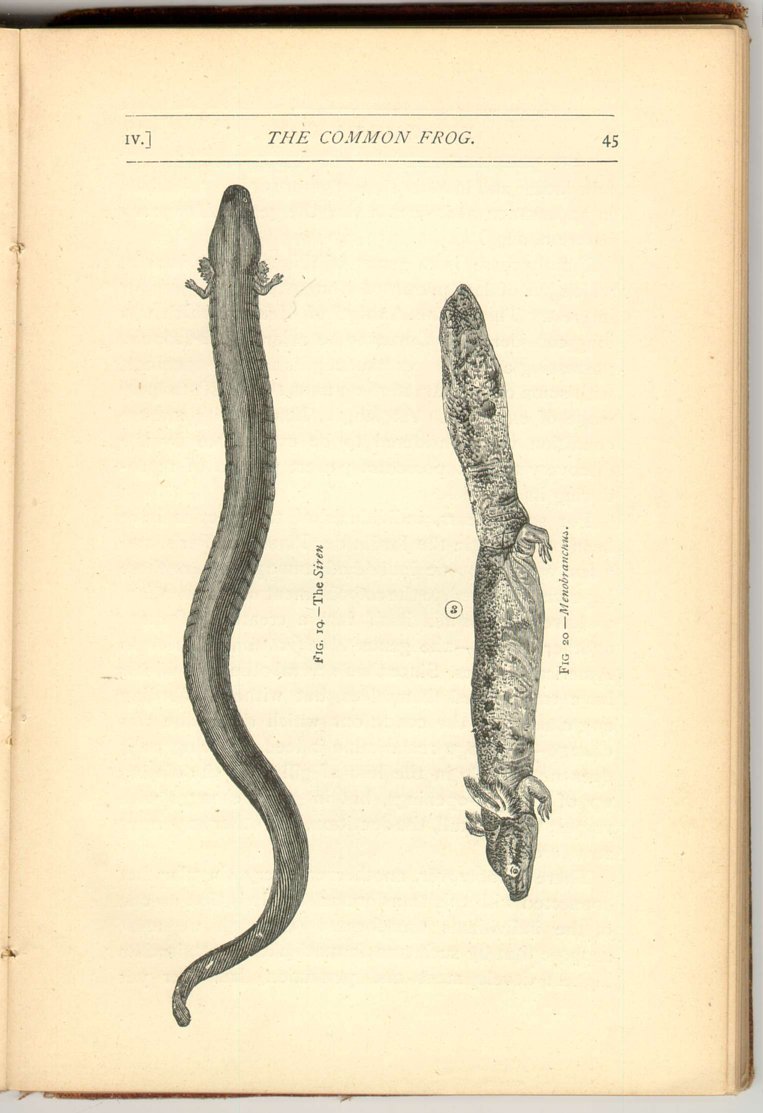 [Description:
Image of page 45.
]
[Description:
Image of page 45.
]
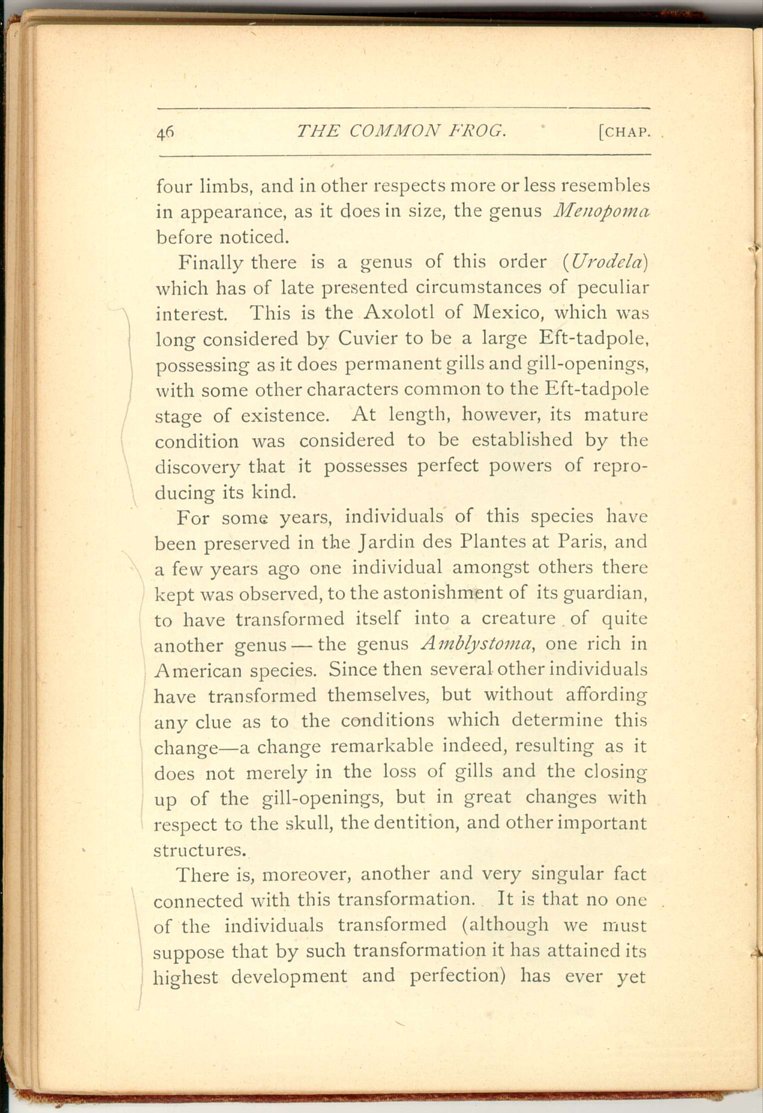 [Description:
Image of page 46.
]
[Description:
Image of page 46.
]
Finally there is a genus of this order (Urodela) which has of late presented circumstances of peculiar interest. This is the Axolotl of Mexico, which was long considered by Cuvier to be a large Eft-tadpole, possessing as it does permanent gills and gill-openings, with some other characters common to the Eft-tadpole stage of existence. At length, however, its mature condition was considered to be established by the discovery that it possesses perfect powers of reproducing its kind.
For some years, individuals of this species have been preserved in the Jardin des Plantes at Paris, and a few years ago one individual amongst others there kept was observed, to the astonishment of its guardian, to have transformed itself into a creature of quite another genus—the genus Amblystoma, one rich in American species. Since then several other individuals have transformed themselves, but without affording any clue as to the conditions which determine this change—a change remarkable indeed, resulting as it does not merely in the loss of gills and the closing up of the gill-openings, but in great changes with respect to the skull, the dentition, and other important structures.
There is, moreover, another and very singular fact connected with this transformation. It is that no one of the individuals transformed (although we must suppose that by such transformation it has attained its highest development and perfection) has ever yet
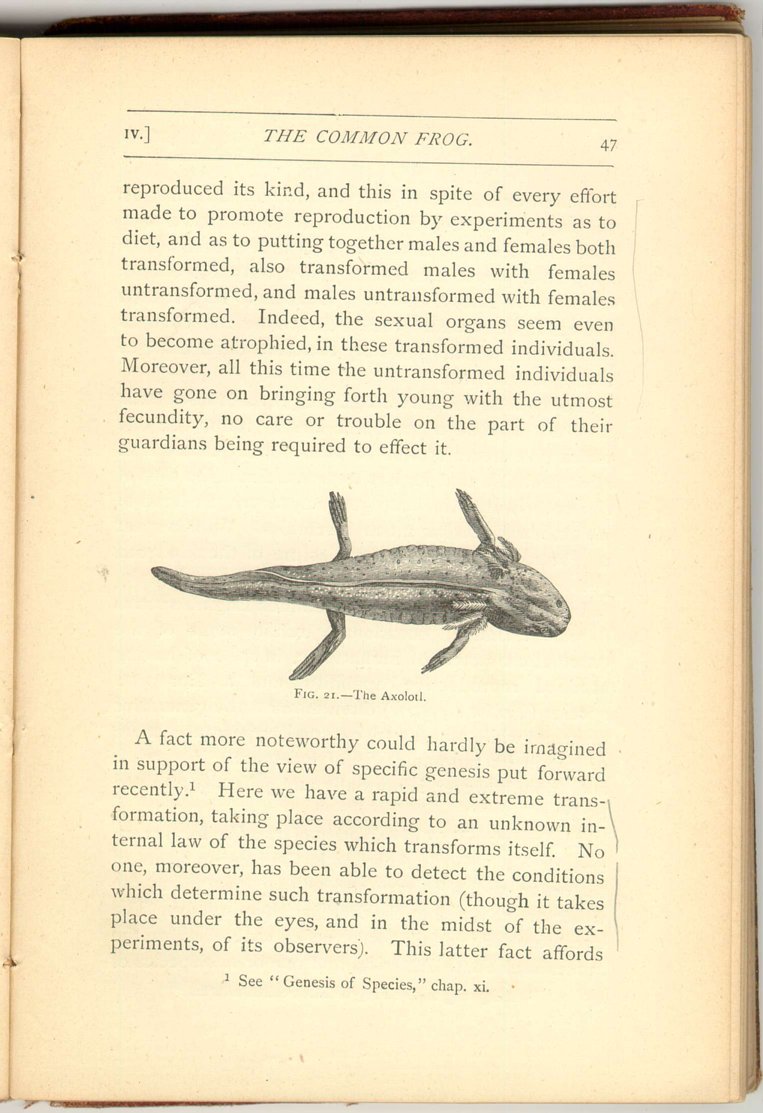 [Description:
Image of page 47.
]
[Description:
Image of page 47.
]
A fact more noteworthy could hardly be imagined in support of the view of specific genesis put forward recently. [11]
Here we have a rapid and extreme transformation, taking place according to an unknown internal law of the species which transforms itself. No one, moreover, has been able to detect the conditions which determine such transformation (though it takes place under the eyes, and in the midst of the experiments, of its observers). This latter fact affords
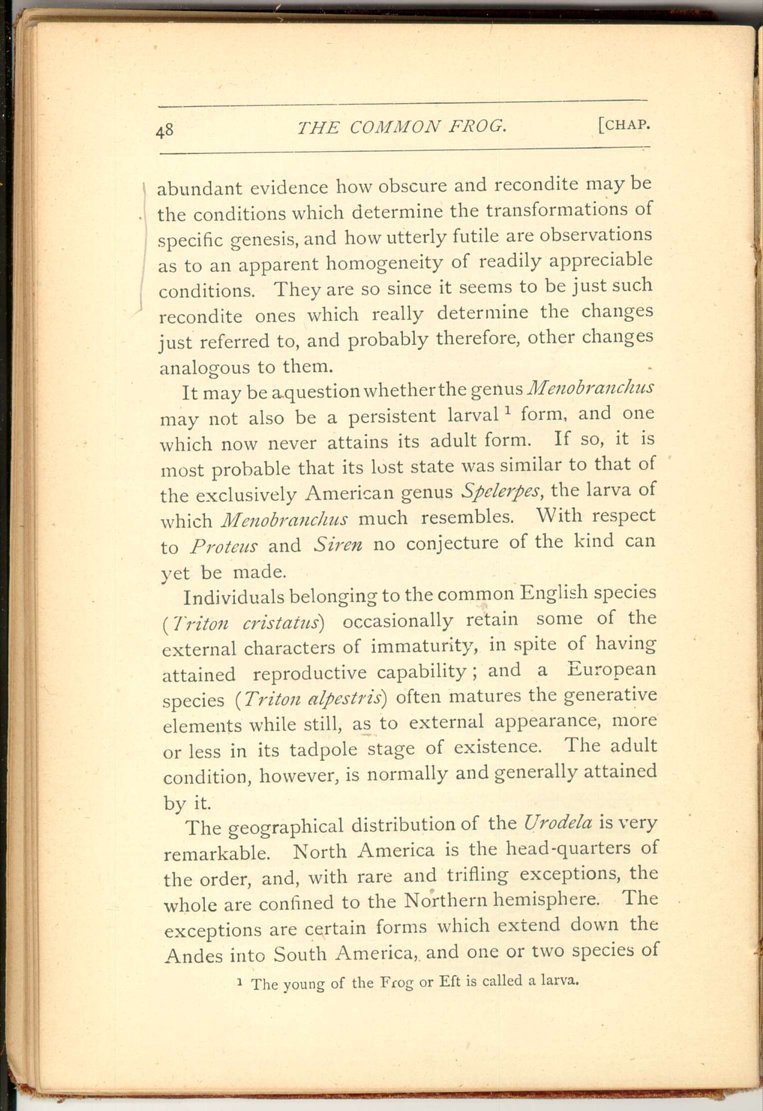 [Description:
Image of page 48.
]
[Description:
Image of page 48.
]
It may be a question whether the genus Menobranchus may not also be a persistent larval [12] form, and one which now never attains its adult form. If so, it is most probable that its lost state was similar to that of the exclusively American genus Spelerpes, the larva of which Menobranchus much resembles. With respect to Proteus and Siren no conjecture of the kind can yet be made.
Individuals belonging to the common English species (Triton cristatus) occasionally retain some of the external characters of immaturity, in spite of having attained reproductive capability; and a European species ( Triton alpestris) often matures the generative elements while still, as to external appearance, more or less in its tadpole stage of existence. The adult condition, however, is normally and generally attained by it.
The geographical distribution of the Urodela is very remarkable. North America is the head-quarters of the order, and, with rare and trifling exceptions, the whole are confined to the Northern hemisphere. The exceptions are certain forms which extend down the Andes into South America, and one or two species of
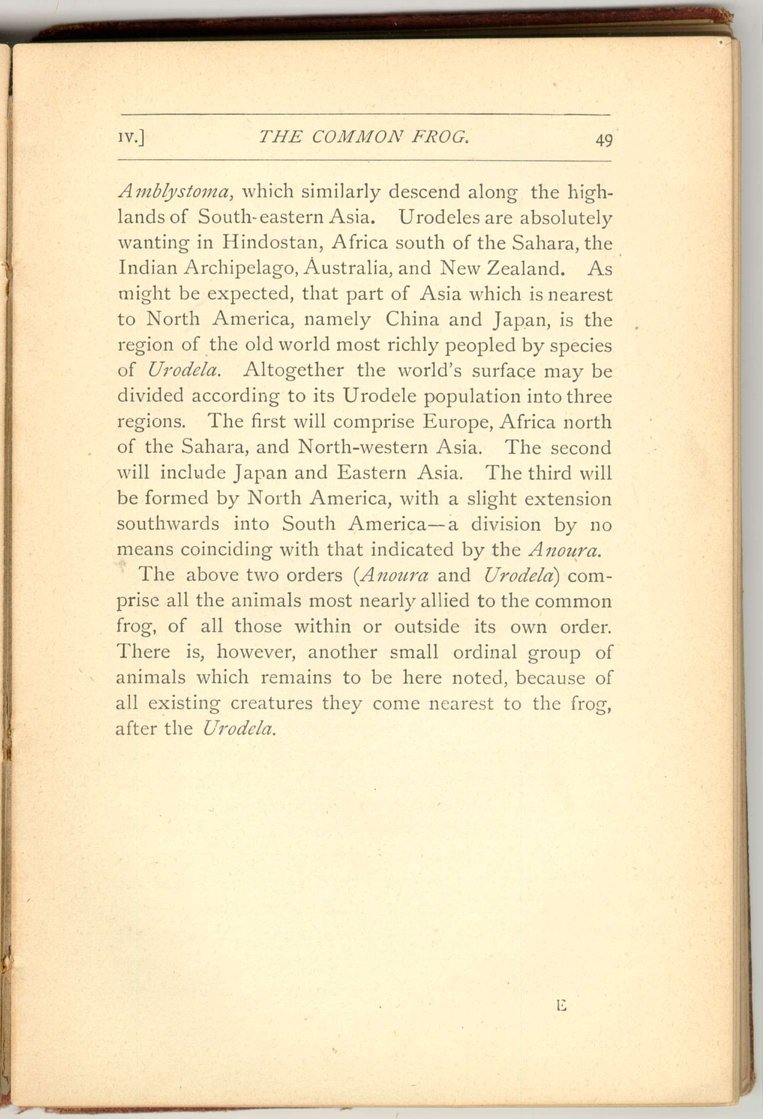 [Description:
Image of page 49.
]
[Description:
Image of page 49.
]
The above two orders (Anoura and Urodela) comprise all the animals most nearly allied to the common frog, of all those within or outside its own order. There is, however, another small ordinal group of animals which remains to be here noted, because of all existing creatures they come nearest to the frog, after the Urodela.
FOOTNOTES: Chapter 4
|
CHAPTER IV.
The Common Frog | ||